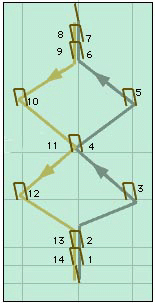Game time of one to two hours; recommended for small, casual gatherings of family and friends; difficult to manage for large group competitions and not recommended for competitive events until you have lots of time and a large stock of equipment to run many games simultaneously.
The game can be played by 2, 3 or 4 players. Toequet is played by kicking the ball; in MalletBall, all the shots are taken with the mallet. The players may agree for any reason to have a “mixed” game in which, for example, the adult uses the mallet, and the child kicks.
 The court layout (seen right) can be set up in any grassy area from 75-150 feet wide by 150-300 feet long. Trees, slopes, and other obstacles only make the court more challenging.
The court layout (seen right) can be set up in any grassy area from 75-150 feet wide by 150-300 feet long. Trees, slopes, and other obstacles only make the court more challenging.
The objective is to pass through wickets 1 to 7, hit the turning stake, and then pass through wickets 8 to 14 and hit the end stake with both your balls before your opponent(s).
Boundaries should be agreed to before starting play. Out of bounds balls are replaced in bounds with no penalty.
Turns are taken in the sequence Blue, Red, Green, Yellow.
2 players – One player plays the Blue and Green balls. The other player plays the Red and Yellow balls.3 players – Each player plays one ball and is on his own – or one player plays both balls of his side.
4 players – Each player plays one ball. Blue and Green are partners. Red and Yellow are partners.
The starting point or tee is midway between the end stake and wicket #1. A turn consists of one kick (or stroke with the mallet) plus any bonus kicks (or strokes) earned. One bonus shot is earned for passing through your target wicket (or hitting the turning stake). Two bonus shots are earned if two target wickets are scored in a single shot.
Two bonus shots are earned for striking another ball. After earning the bonus shots from another ball you must pass through your target wicket (or hit the turning stake if that is your next point to be scored) before you can earn bonus shots from that ball again. (In the language of croquet, you are said to be “dead” on any ball you have struck since scoring your last wicket, and you may not hit it again to earn bonus strokes until you “clear” yourself by scoring your next wicket.)
For the first of your two earned bonus shots, you have this choice:
1. Place your ball against the struck ball and hold your ball in place. Strike your ball and “send” the other ball while your own ball remains stationary. (There is no penalty if your ball happens to move.)
2. Place your ball against or as near as possible to the struck ball in any direction and strike your own ball, causing both balls to move in the calculated directions.
3. Place your ball away from the struck ball up to a distance of one step and strike your own ball without impacting the previously struck ball.
Whichever of the three options you chose for the first bonus shot, you take your second shot from where your ball stopped after the first bonus shot.
Bonus shots may not be accumulated. If both a target wicket is made and another ball is hit in a single shot only the first accomplished counts.
If another player knocks your ball through your target wicket the wicket counts but no bonus shots are earned for your side.
Once a ball has passed through wicket 14 but has not hit the end stake it is a Rover. Rovers can earn bonus shots from all the other balls in a turn, but may not hit the same ball twice in a turn.
Disputes are resolved by the shooter, unless there is a designated referee for a shot in question. All local variations to these rules are permissible.
PLAY THESE VARIATIONS OR MAKE UP YOUR OWN GAMES!
GOLF TOEQUET AND GOLF MALLETBALL allow you to bring the golf course to your own big backyard or park. You design the course and establish par and let the games begin. No more lost balls, and the games can be played by one or more. One suggestion: Set each wicket open to your tee so a hole in one is always possible.
CROQUET BOWLS is a good pacifier game for children irrestibly attracted to those big and brightly colored balls. Simply create a line and put up a stake some distance away, and instruct the children to kick or throw the ball to the stake from anywhere behind the line, following the rotation of the colors. The ball(s) closest to the stake at the end of the four-ball round wins the point(s), and the first team to ten points wins the game.